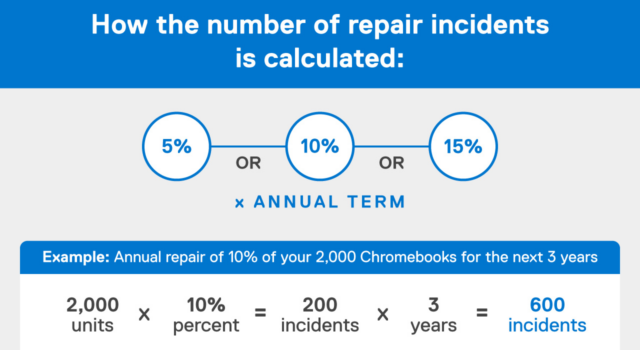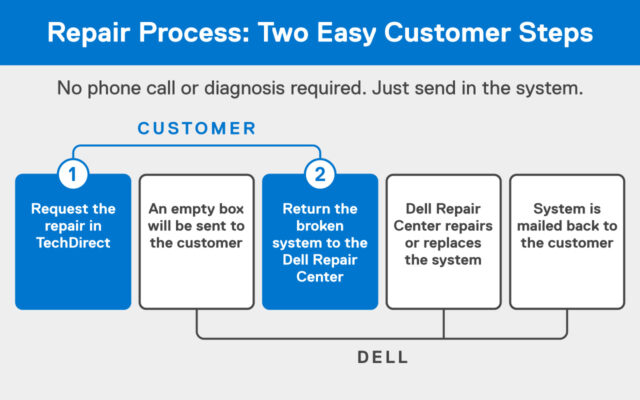Schools see it all. Tech devices all too often fall victim to damage, especially as students transition back-and-forth between at-home and in-person learning during another year of the COVID-19 pandemic. Damage incidents – at home, at school and on the go – are varied and unpredictable. Because face it, kids will be kids. Consider these examples:
-
-
- Jonathan, a straight-A ninth grader, has excellent classroom habits except for one. He sometimes forgets to remove his pen from the keyboard as he slams his laptop shut at the end of class. The result: damaged keys and a gouged screen.
- Riley, age eight, gets lost in her excitement of it being Friday and the weekend ahead, and in her rush down the stairs in the morning drops her backpack with her Chromebook inside. It goes tumbling ahead of her.
- Connor, a senior, is a perfectionist in choir and drama, but when it comes to tech devices, not so much. His laptop endures more wear and tear than his faded jeans, so it’s no surprise he needs a screen replacement every few months.
-
Multiply these incidents by hundreds or even thousands of times per year for any given school district and imagine the impact on already strained IT budgets, staff resources and, of course, students who depend on their computing hardware day and night. Just as previous generations lugged traditional textbooks between school and home, today’s K-12 students rely on laptops for eLearning, online textbooks, web-based research, assignments, quizzes and more. Keeping students up and running with reliable hardware in good repair is critical to their academic success.
At Dell Technologies, we understand the challenges facing K-12 IT customers. Our Student Technology Services is designed to provide end-to-end tech support beyond the academic calendar, with the goal to help you optimize your IT investment and improve student outcomes – maximizing learning time.
Coverage above and beyond
We’ve expanded our tech services portfolio with an innovative offering – Comprehensive Hardware Support (CHS). Designed for IT support for K-12 schools in the United States, CHS is a bumper-to-bumper service that allows districts to purchase coverage for incidents in advance based on their projected needs, offering peace of mind that hardware maintenance and repairs are covered throughout the year. CHS eliminates the need to go back to the well for more budget while keeping students learning all year long.
Available only from Dell Technologies, CHS is a unique hardware support offering not offered by any other PC vendor for K-12 schools in the U.S. Delivering comprehensive coverage above and beyond accidental damage, CHS provides hardware repairs for almost anything that goes wrong with a Dell Chromebook or Latitude 3000, 5000 or 7000 series laptop outside of a standard warranty or a service contract, including accidental and intentional damage, non-cosmetic wear and tear and battery replacement.¹ If a broken system is deemed beyond economical repair Dell will replace the device.
CHS is a cost-effective budgetary solution for K-12 customers designed to fill the gaps in coverage left by standard hardware service plans. It can be used either as a stand-alone alternative to Dell’s Accidental Damage or as a supplement for maximum hardware protection. For instance, customers can use their Accidental Damage Service for one accident per year and then apply CHS to cover additional accidents and anything else not covered by Accidental Damage on the same service tag in the same year.
CHS differs from standard Accidental Damage Service in two ways:
-
- First, it covers more than just accidents (i.e., it also covers student-induced damage, wear and tear and batteries), and there’s no limit to the number of repair incidents per system each year.
- Second, CHS provides a set number of repair incidents based on the term of the contract and a percentage of the number of systems the customer is purchasing.
How it works
CHS offers flexible service options allowing you to right-size your repair incident purchase based on your unique student population, personalized learning model and budget.
Below is an example scenario to demonstrate how CHS works:
 A choice of three percentage models determines how many annual repairs the customer is entitled to for the term of their service. Customers can purchase repairs for 5% of their total Dell systems, 10% of their systems or 15% of their systems. The term periods are also flexible. For education Chromebooks and Latitude 3000, 5000, and 7000-series laptops, CHS is available for up to four years, with an optional fifth year offered for Latitude devices.
A choice of three percentage models determines how many annual repairs the customer is entitled to for the term of their service. Customers can purchase repairs for 5% of their total Dell systems, 10% of their systems or 15% of their systems. The term periods are also flexible. For education Chromebooks and Latitude 3000, 5000, and 7000-series laptops, CHS is available for up to four years, with an optional fifth year offered for Latitude devices.
CHS is available to customers at point of sale (POS) and also after point of sale (APOS) for existing CHS customers who run out of incidents and need additional coverage or for customers who didn’t purchase CHS at point of sale. Customers with existing Dell Chromebooks or Latitude PCs that are still under warranty can upgrade and add APOS CHS coverage to those systems. The APOS CHS option is available as incident packs that come in groups of 10, 25, 50, 100, 200 and 500 incidents.
Get started today
Customers with CHS access can submit incident requests online through Dell’s TechDirect online portal. No diagnosis is required. If it’s broken we’ll fix it – no questions asked.
And the repair process is just as easy. CHS is delivered through Dell’s standard, hassle-free mail-in service process using our hardware repair center in Houston, Texas — the same location that handles all of Dell’s in-warranty repairs. And for you, the customer, it’s as easy as two steps:
 The great thing about CHS is that it gives K-12 IT departments a lot of budgetary flexibility. Simply invest in the right level of coverage for your budget, without overspending or buying more coverage than you really need. CHS makes computer hardware repairs easy and affordable for each school’s needs, keeping your students up and running, productive and inspired throughout the year.
The great thing about CHS is that it gives K-12 IT departments a lot of budgetary flexibility. Simply invest in the right level of coverage for your budget, without overspending or buying more coverage than you really need. CHS makes computer hardware repairs easy and affordable for each school’s needs, keeping your students up and running, productive and inspired throughout the year.
To learn more about Dell’s Student Technology Services, click here.
¹ CHS coverage does not include coverage for Rugged systems and does not cover “acts of God” such as damage caused by fires and flood and cannot be used in the event o theft or loss.


